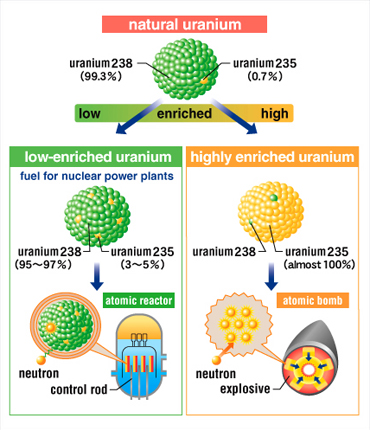 How are atomic bombs different from nuclear power generators? How are atomic bombs different from nuclear power generators?
 Atomic bombs initiate a sudden chain reaction of nuclear fission, while atomic reactors in nuclear power generators regulate this chain reaction at a slower pace. Atomic bombs emit large amounts of radiation, while nuclear power generators are constructed to prevent radiation from escaping externally. Atomic bombs initiate a sudden chain reaction of nuclear fission, while atomic reactors in nuclear power generators regulate this chain reaction at a slower pace. Atomic bombs emit large amounts of radiation, while nuclear power generators are constructed to prevent radiation from escaping externally.
Differences between nuclear power plants and atomic bombs
 |
Nuclear fission is a phenomenon in which neutrons are forced to collide with uranium-235 nuclei or the like, causing the nuclei to split in two and emit a neutron. Neutrons emitted during nuclear fission collide with other uranium nuclei, and this process is repeated, setting off a fission chain reaction. The amount of energy released during fission is extremely large. To produce this energy, atomic reactors in nuclear power plants use a ratio of about 3-5% uranium-235 in a fuel and carefully regulate this ratio to produce a gentle fission chain reaction. Careful attention is given to ensure radiation does not escape. Atomic bombs, on the other hand, produce a rapid fission chain reaction to release a large amount of energy at once.
If the amount of uranium or other matter capable of generating nuclear fission is too small, the neutrons produced from the fission will scatter and not continue the chain reaction. To produce an instant chain reaction, it is necessary to use a near 100% concentration of uranium-235 or plutonium-239 (239Pu) at a fixed amount or greater. This fixed amount is called the critical quantity. For example, the uranium-235 bomb used on Hiroshima required at least 15 kilograms of uranium, while the bomb dropped on Nagasaki required at least 5 kilograms of plutonium. The uranium-235 was compartmentalized in the bomb to prevent it from exceeding its critical quantity during transport. To explode the bombs, gunpowder explosions quickly forced all the matter into one area, at which time the critical quantity was exceeded, generating a sudden chain reaction.
In atomic reactors, such as the Genkai Nuclear Power Plant in Japan, hardened pellets formed by baking uranium powder are packed in tubes to form fuel rods.? A fuel assembly is created by assembling the fuel rods in a lattice construction, and the amount of uranium-235 is adjusted near the critical quantity. The amount of neutrons is regulated by inserting and withdrawing a control rod to control the reaction.
The critical-mass accident that occurred in Tokaimura was the result of workers ignoring regulations and treating all at once an amount of uranium-235 exceeding the critical quantity. In the accident that occurred in Chernobyl, the atomic reactor went out of control, causing a rapid fission chain reaction.
Reference:
Yasashii Hoshasen to Aisotopu (Easy Radiation and Isotopes), Japan Radioisotope Association
|

